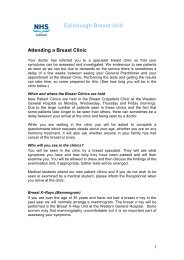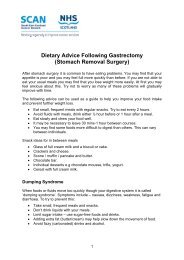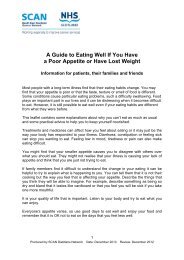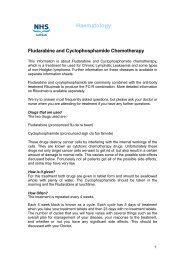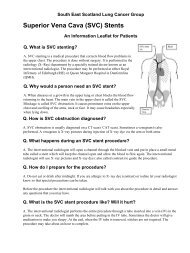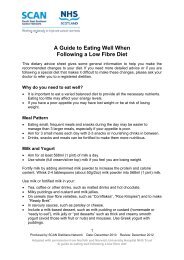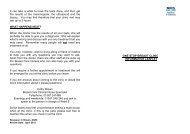Your Nephrostomy Tube: A Patient's Guide - SCAN
Your Nephrostomy Tube: A Patient's Guide - SCAN
Your Nephrostomy Tube: A Patient's Guide - SCAN
You also want an ePaper? Increase the reach of your titles
YUMPU automatically turns print PDFs into web optimized ePapers that Google loves.
<strong>Your</strong> <strong>Nephrostomy</strong> <strong>Tube</strong>: A <strong>Patient's</strong> <strong>Guide</strong><br />
NHS Lothian<br />
<strong>Nephrostomy</strong> <strong>Tube</strong><br />
Care<br />
• A nephrostomy tube is a drainage tube placed directly into your kidney<br />
through the skin surface on your back. It is usually put in because you have a<br />
blockage in your urinary system which prevents that kidney from draining<br />
properly into your bladder.<br />
• As the tube is placed directly into your kidney, it is important that it be kept<br />
clean and that you drink extra fluids to flush out any infection or debris.<br />
• <strong>Your</strong> other kidney will continue to function as before therefore you will<br />
continue to pass urine in the normal way. If you have a tube in both sides,<br />
then you are not likely to pass urine in the normal way.<br />
• If you have any problems with your nephrostomy tube, contact your District<br />
Nurse or your hospital ward/department. Should your tube become displaced<br />
(not draining any urine into the bag) or accidentally pulled out, contact<br />
your GP immediately. They will arrange for you to be seen urgently by a<br />
urologist and a radiologist will have it replaced.<br />
• Hygiene − thoroughly soap and water hand wash before emptying the bag via the valve. Note the<br />
colour and amount of urine drained. Report to your GP if your urine is smelly, bloody, or stained.<br />
• Ensure that the tube is securely fixed by a dressing over it, taping the tube to your side and using a<br />
safety pin to fix the bag to your clothing. The tubing and drainage bag should be supported and not<br />
'kinked' and kept below the level of the kidney (hip−joint). Do not allow the bag's weight to drag on<br />
the tube.<br />
• Check the dressing daily and change it as required, more frequently if necessary due to discharge or<br />
dampness. If 'Niko−fix' dressings are used, once a week is sufficient, <strong>Your</strong> District Nurse will advise<br />
regarding times.<br />
• A bath or shower may be taken with care.<br />
• Change the drainage bag every 7 days.<br />
• <strong>Your</strong> District Nurse will be contacted by the hospital on your discharge and will help with dressings<br />
and bags.<br />
• Further supplies of bags may be obtained by phoning your ward. Please phone before you use your<br />
last one to allow time to get them in the post.<br />
• If your tube is necessary as a long or short term measure, it needs to be changed in approximately 3<br />
months. Before you leave the ward, ensure that you have your next hospital appointment or review<br />
date.<br />
Removal<br />
• When your tube is no longer needed, it must be removed in hospital (possibly as a day case).<br />
• The tube must be clamped for several hours before removal. You are advised to report any new pain<br />
or leakage which may indicate that you still need the tube.<br />
• The tube is released by cutting the retaining stitch, and gently removing the tube. A dressing is<br />
applied to the area and checked for leakage.
When should I call my GP?<br />
If you experience any of the following, you should call your doctor.<br />
1. You feel unwell with a fever.<br />
2. You experience severe pain that is not controlled by painkillers.<br />
3. The tube becomes blocked.<br />
4. The tube falls out.<br />
5. If you are unable to contact the hospital ward or department.




